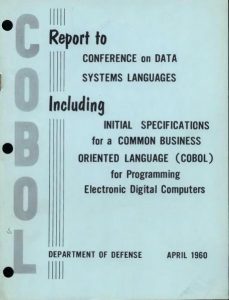Ähnlich wie »Nessie« taucht ein weiterer Dinosaurier mit schöner Regelmäßigkeit1Wie z. B. in der »Computerwoche« vom 19.12.2000 immer wieder auf: COBOL
Aktuell ist durch die Crona-Krise wieder sichtbar geworden, was für komplexe IT-Systeme seit vielen Jahren »einfach laufen«, ohne viel von sich reden zu machen. Wenn jedoch ad hoc Anpassungen notwendig sind, kann es eng werden:
More than 10 million people in the United States have filed for unemployment amid the COVID-19 global pandemic and financial crisis. As these numbers continue to grow, a big technology skills gap is starting to emerge as well.
For example, earlier this week, New Jersey Governor Phil Murphy put out a call for volunteers who have COBOL skills because – like most states – New Jersey depends on mainframes to control, manage and secure citizens’ data. Many states are following with the same call for volunteers. This pandemic underscores the critical nature for public sector mainframe applications to be agile and easily modified to meet fast-changing requirements.
Quelle: Open Mainframe Project Helps Fill the Need for COBOL Resources.. Das Thema wurde auch in vielen anderen Medien, wie CNN, Newsweek u. a. verbreitet.)
Das habe ich zum Anlass genommen, hier eine kleine Serie für Interessierte zu beginnen. Es soll kein systematischer Kurs werden (die gibt es nämlich), sondern so eine Art »museumsdidaktischer Rundgang« mit der Möglichkeit zu praktischen Experimenten und weiterführenden Hinweisen.
Bitte beachten: Die praktischen Hinweise gelten für Rechner mit Windows 10.
Meine eigenen Erfahrungen mit COBOL reichen bis ins Jahr 1972 zurück. Damals sah ich als Lehrling zum ersten Mal ein Programm für einen Siemens 4004-Rechner. Ab 1976 arbeitete ich dann im Studium mit einem Telefunken TR 4. Anschließend in einem Softwarehaus mit IBM OS/VS-COBOL an einem IBM /370, der IBM 4300-er Serie unter DOS/VSE, der ICL 29-er Serie, der Siemens 7000-Serie unter BS2000, zuletzt in den 1990-er Jahren mit IBM /36 und AS/400.
Und bevor wir beginnen, noch die obligatorische Danksagung (COBOL standard acknowledgment):
COBOL is an industry language and is not the property of any company or group
of companies, or of any organization or group of organizations.No warranty, expressed or implied, is made by any contributor or by the CODASYL
COBOL Committee as to the accuracy and functioning of the programming system
and language. Moreover, no responsibility is assumed by any contributor, or by
the committee, in connection therewith.The authors and copyright holders of the copyrighted materials used herein
FLOW-MATIC (trademark of Sperry Rand Corporation), Programming for the UNIVAC
(R) I and II, Data Automation Systems copyrighted 1958, 1959, by Sperry Rand
Corporation; IBM Commercial Translator Form No. F28-8013, copyrighted 1959 by
IBM; FACT, DSI 27A5260-2760, copyrighted 1960 by Minneapolis-Honeywellhave specifically authorized the use of this material, in whole or in part, in
the COBOL specifications. Such authorization extends to the reproduction and
use of COBOL specifications in programming manuals or similar publications.Any organization using a short passage from this document, such as in a book
review, is requested to mention “COBOL” in acknowledgment of the source.
(Bild: CODASYL / Public domain)

